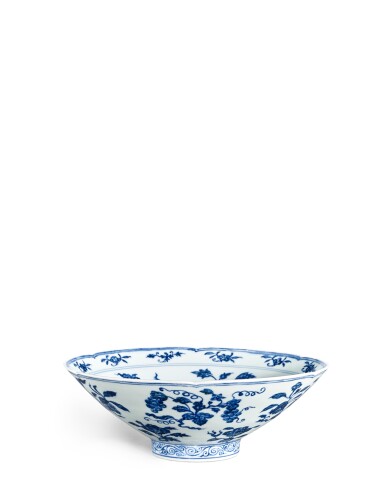
A fine and very rare blue and white lobed bowl, Mark and period of Xuande | 明宣德 青花折枝花果紋葵式盌 《大明宣德年製》款
Live auction begins on:
November 21, 10:00 AM GMT
Estimate
3,000,000 - 6,000,000 HKD
Lot Details
Description
of conical form with a six-lobed rim supported on a slightly tapered foot, finely painted in rich cobalt blue accentuated with characteristic 'heaping and piling', the interior centred with a medallion enclosing a flowering peach branch, surrounded by three lotus sprays alternating with sprays of tree peony, chrysanthemum, and herbaceous peony, all beneath a narrow border of twelve small floral sprigs at the rim, the exterior decorated with six large fruit sprays, comprising peach, cherry, loquat, pomegranate, grape, and lychee, alternating with six smaller sprays of flowers below, including camellia, chrysanthemum, lotus, rose, peony, and one other flower, the foot further encircled by a classic scroll, the base inscribed with a six-character reign mark within a double circle
22.8 cm
Collection of President Herbert Hoover (1874-1964).
Collection of Mr and Mrs Allan Hoover (1907-1993).
Collection of Ira and Nancy Koger.
Sotheby’s New York, 27th November 1990, lot 6.
Freely painted in cobalt blue with vibrant sprays of blooms and fruiting branches, the present bowl is an elegant and rare example of a much-coveted imperial design.
With bold conical walls indented with the suggestion of floral lobes, the present form is derived directly from white-glazed Qingbai wares of the Song dynasty. Compare, for example, a Qingbai bowl of this form preserved in the Metropolitan Museum of Art, New York (accession no. 91.1.389), illustrated on the Museum’s website. However, while this design continued to be produced at Jingdezhen in various monochrome glazes during the Ming dynasty (1368–1644), most monochrome examples appear to have been destroyed at the kiln site with the imperial potters opting instead for the favoured palette of the 15th century; blue and white.
Another bowl of this design of Xuande mark and period is preserved in the Qing court collection at the Palace Museum, Beijing, illustrated in Geng Baochang, ed., Gugong Bowuyuan cang Ming chu qinghua ci [Early Ming blue and white porcelain in the Palace Museum], Beijing, 2002, vol. 2, pl. 146, together with a Kangxi copy of spurious Xuande mark, pl. 179. Also compare two Xuande bowls of this design in the Palace Museum, Taipei, included in Mingdai Xuande guanyao jinghua tezhan tulu / Catalogue of the Special Exhibition of Selected Hsüan-te Imperial Porcelains of the Ming Dynasty, Taipei, 1998, cat. no. 62, and Ming Xuande ciqi tezhan mulu / Catalogue of a Special Exhibition of Hsuan-te Period Porcelain, Taipei, 1980, cat. no. 36, the latter together with another Qing copy of similar design, cat. no. 35; and a fourth unmarked bowl, also in Taiwan, likely predating the Xuande examples, included in the Mingdai chunian ciqi tezhan mulu / Catalogue of a Special Exhibition of Early Ming Period Porcelain, Taipei, 1982, cat. no. 20. Another bowl of Xuande mark and period in the Capital Museum, Beijing, is published in Shoudu Bowuguan cang ci xuan [Selection of porcelains from the Capital Museum], Beijing, 1991, pl. 97; and another, in the Shanghai Museum, in Lu Minghua, Shanghai Bowuguan zangpin yanjiu daxi/Studies of the Shanghai Museum Collections: A Series of Monographs. Mingdai guanyao ciqi [Ming imperial porcelain], Shanghai, 2007, pl. 3-34.
Bowls of this type are rarely preserved in private collections. Compare one example in Regina Krahl, Chinese Ceramics from the Meiyintang Collection, vol. II, London, 1994, pl. 671, from the collections of K.L. Dawes, John F. Woodthorpe and Frederick Mayer, sold in our London rooms, 6th April 1954, lot 24, and again in these rooms, 5th October 2011, lot 12; another example from the collections of R.H.R Palmer and the Tsui Museum of Art, Hong Kong included in Selected Treasures of Chinese Art, Min Chiu Society Thirtieth Anniversary Exhibition, Hong Kong Museum of Art, Hong Kong, 1990, cat. no. 133, and sold twice at Christie’s Hong Kong, 17th January 1989, lot 567 and 3rd November 1996, lot 546; and a third example from the H.R.N. Norton and Pilkington Collections, sold most recently in these rooms, 5th April 2016, lot 20.
As evidenced by the varied dating of Palace Museum examples, the present design continued to remain popular in the imperial court throughout the Ming and Qing dynasties; reproduced in the sixteenth, seventeenth and eighteenth centuries. Compare three other bowls of this design – similarly preserved in the Hoover and Koger Collections and sold in our New York rooms, 27th November 1990: lot 9, of Wanli mark and period; and lot 8, a pair of bowls bearing an apocryphal Xuande mark but of eighteenth century date.
President Herbert Hoover and his wife Lou created a very fine collection of Chinese blue and white porcelain. The pair began collecting during their time in China around 1900 while Hoover served as a mining engineer in Tianjin, and maintained their passion on their return to the United States. The president continued adding to the collection, which contained over four hundred pieces at its height, until his death in 1964 – some twenty years after his wife's passing.
來源
美國第三十一任總統胡佛(1874-1964年)收藏
艾倫.胡佛伉儷(1907-1993年)收藏
Ira 及 Nancy Koger 伉儷收藏
紐約蘇富比1990年11月27日,編號6
本品以明快鈷藍彩自由繪就繁花碩果紋樣,實乃備受推崇的宮廷御製瓷器典範。其大膽的斗笠形盌壁隱約可見花葉輪廓,此造型承襲自宋瓷傳統器型,如紐約大都會藝術博物館藏一件青白釉盌,館藏編號91.1.389。然明代景德鎮雖延續此形制生產各類單色釉瓷,多數單色器皿卻遭窰廠銷毀,因御窰匠人獨鐘十五世紀盛行的青花瓷。
北京故宮博物院清宮舊藏一件宣德款同類,參見耿寶昌編,《故宮博物院藏明初青花瓷》,第二卷,北京,2002年,圖版146,同書圖版179收錄一件康熙仿宣德款器亦資參考。另見台北故宮博物院藏兩例宣德款盌,參見《明代宣德官窯精華特展圖錄》,台北,1998年,編號62;《明宣德瓷器特展目錄》,台北,1980年,編號36,後者與一件清代仿品並列,編號35。台北另藏一件無款盌,見《明代初期瓷器特展目錄》,1982年,編號20,年代或早於宣德。首都博物館藏一例,載於《首都博物館藏瓷選》,1991年,圖版97,上海博物館藏一例,見陸明華編,《上海博物館藏品研究大系:明代官窯瓷器》,2007年,圖版3-34。
此類盌器私人收藏極為罕見。可資比較有玫茵堂藏一例,參見康蕊君,《玫茵堂藏中國陶瓷》,第二卷,1994年,圖版671,曾屬K.L. Dawes、John F. Woodthorpe及Frederick Mayer舊藏,1954年4月6日售於倫敦蘇富比,編號24,2011年10月5日覆售於香港蘇富比,編號12;又有徐氏藝術館藏一例,見《敏求精舍三十周年展覽》,1990年,編號133,1989年1月17日及1996年11月3日兩度經香港佳士得釋出,編號567、546);另見H.R.N. Norton及Pilkington舊藏一例,2016年4月5日售於香港蘇富比,編號20。
縱觀故宮博物院藏品之年代分布,此紋樣在明清兩朝持續流行,十六至十八世紀均有仿製。可資比對者包括胡佛與科格伉儷舊藏三例同類盌器:一件萬曆本朝款器,1990年11月27日售於紐約蘇富比,編號9,以及一對十八世紀仿宣德款器,同場拍品,編號8。
赫伯特·胡佛總統(1874-1964年)與夫人Lou共同建立了極為精良的中國青花瓷收藏體系。二人約1900年胡佛任天津礦業工程師時即開始收藏,返美後仍延續此雅好。夫婦二人之收藏鼎盛時達四百余件,在夫人離世已二十載後,總統先生仍然持續擴充直至1964年逝世。
You May Also Like








